From time to time you may experience problems with your snails. Very little is known about what these illnesses are, what causes them, and even less is known about treatments. Unfortunately it seems more time is spent on increasingly more ingenious ways to kill them.
Because of this, the following information is a mix of whatever research is possible and available, theory and hypothesis, logical thinking and the result of various discussions with a large group of snail owners. It is with the help of the community at large, that these problems can at least be documented. Where possible I have tried to link to example incidents.
Hopefully, we can find some effective solutions to the majority of these problems but for now I'm afraid you'll have to be content with various suggestions and discussion.
Flies
There are a number of different flies that may infest your tank. The most likely culprits are Sciarid flies, Drosophilid flies (fruit flies), Phorid flies or Sphaerocerid flies.
An entomologist who was sent a sample of a fly from a snail tank said the following. The fly belonged to the Sciaridae family:
"Sciarid flies are likely to be encountered in a variety of situations in which rotting vegetation and/or animal content (dung) is present. They are a native species to Britain and all of Europe, with a normal (outdoor) cycle of 3 weeks. Indoors, this is 2 weeks, and in a heated tank this can be as little as seven days.
On a practical level this means that you should be removing vegetation and faeces daily, and if you use a heat source changing the soil completely and cleaning all tank contents every WEEK. This will take care of the problem. If you don't use a heater, 10-14 days should suffice. If you have plants in your house you will have them anyway, and you will struggle to get rid of them entirely.
Phoridae (or phorid flies - called scuttle flies because they race around on the surface of the soil) and Sphaeroceridae (lesser dung flies) are also common in houses and may be among the culprits.
Drosophilidae (fruit flies) will be present too, associated with rotting fruits and vegetables. These are what are caught by those of you who are setting vinegar traps. They are light brown as opposed to black, and slightly more bulky than the others."
You will encounter both the flies and the larval stage which is usually a maggot or a grub-like creature. Cleaning all your tanks out to remove flies, larvae and eggs is a must but this may not completely solve the problem. It is likely your tanks will be re-infected so-to-speak by stray flies lurking in the room.
Any sort of pesticide is definitely out of the question and mosquito nets over the tank simply do not work because mosquitoes are quite large and the holes are too big. Micromesh and professional nets are expensive.
Chiffon
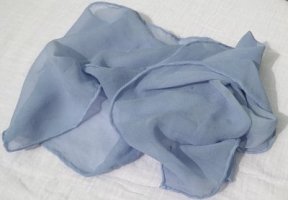
The answer to the problem is Chiffon. It is reasonably cheap and the holes are small enough to keep out any type of fly, yet it easily lets air and light through. By covering your tanks with this after you've cleaned them all out you will stop the flies being reintroduced and within 10-14 days the problem should have been beaten. If you keep plants in the room you will find it harder to get rid of some types of flies and in cases like this it may be necessary to build a more permanent chiffon-covered lid for your tanks.
It is also worth mentioning that Hypoaspis miles predatory mites are known to eat some of the larvae but it is an expensive option that is unlikely to be 100% successful and we have the luxury of being able to clean out tanks and throw away or sterilise the soil.
Drosophilidae (Fruit Flies)
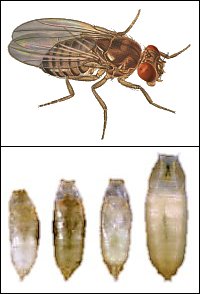
Fruit flies are small flies measuring about 3-4 mm. in length, including their wings. The key identifying characteristic of the fruit fly is its eyes, which are red in colour. The head and thorax are tan in colour with the abdomen somewhat darker. This fly is easily mistaken for the Phorid fly which has very similar markings but lacks the distinct red eye colour. The Phorid fly also has a "humped back" appearance.
Fruit flies lay their eggs near the surface of fermenting foods or other moist, organic materials. Upon emerging, the tiny larvae continue to feed near the surface of the fermenting mass. The reproductive potential of fruit flies is enormous; given the opportunity, they will lay about 500 eggs. The entire lifecycle from egg to adult can be completed in about a week. Like most flies they can transfer bacteria to and from food sources.
It is this type that you can catch using vinegar traps and yellow sticky pads. However, it simply isn't worth it, you will never manage to catch enough to slow down their inevitable population explosion. These measures are good for cleaning up any escapees in the room after your tanks have been cleaned out and the chiffon applied over the top.
Sciaridae (Fungus Gnats)
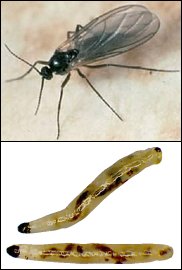
Adult flies are usually 3-4 mm. long and with the naked eye can be distinguished from the other fly pests you are likely to find by their long antennae, black shiny heads, long legs and long thin wings. They look like tiny mosquitoes.
Sciarids are compost feeders. The adult flies are attracted by by rotting vegetation, so compost is an ideal substrate for them.
Fungus gnats have four developmental stages: egg, larva, pupae and adult. The female adult flies deposit between 50 to 300 eggs (0.2mm) in the compost and the developing larvae pass through four moults (varying in size from 1 to 8 mm) before pupating.
Outbreaks of high fungus gnat populations are linked to high humidity and soil moisture levels, this may have something to do with the insect's vulnerable egg stage. Fungus gnat eggs are very much subject to desiccation. When the moist conditions that favour egg development are present in a species that goes from egg to adult in only 10 to 14 days, populations are likely to boom. High humidity and soil moisture encourage the growth of the larval stage.
Phoridae (Humpbacked flies)
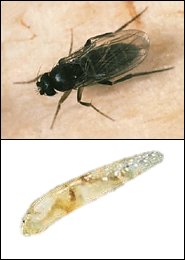
The phorids, also known as humpbacked flies, are small to minute flies that resemble fruit flies in appearance. The Phorid fly lacks the red eye colour that is the classic trademark of the fruit fly. Phorid flies are in the small category of flies, measuring up to 3-4 mm. in length, including the wings. The most prominent feature of this fly is the humpbacked shape of its thorax. The severe arch of the thorax gives it the common nickname of humpbacked fly. The most easily recognised feature (seen with the naked eye) is the habit of the adult Phorid fly running rapidly across surfaces instead of immediately flying when disturbed. Most flies immediately take flight.
They are unable to fly when the temperature falls below 12°C. The larvae are white, 1 to 6 mm long, are stubby at one end and have a pointed head at the other. They can be distinguished from sciarid larvae by the absence of the black head and they develop more rapidly into a pupae.
Sphaeroceridae
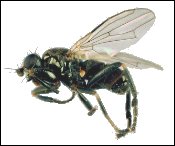
These small flies have dark coloured bodies and are about 3-4 mm. in length, making proper identification difficult without magnification. The tarsi (last 5 segments of the hind leg) is the key to identifying the Sphaerocerid fly. On this particular fly, the first segment of the tarsi is greatly enlarged. Most flies of this family generally breed in animal manure but there are a few species that feed in any decaying organic matter.
